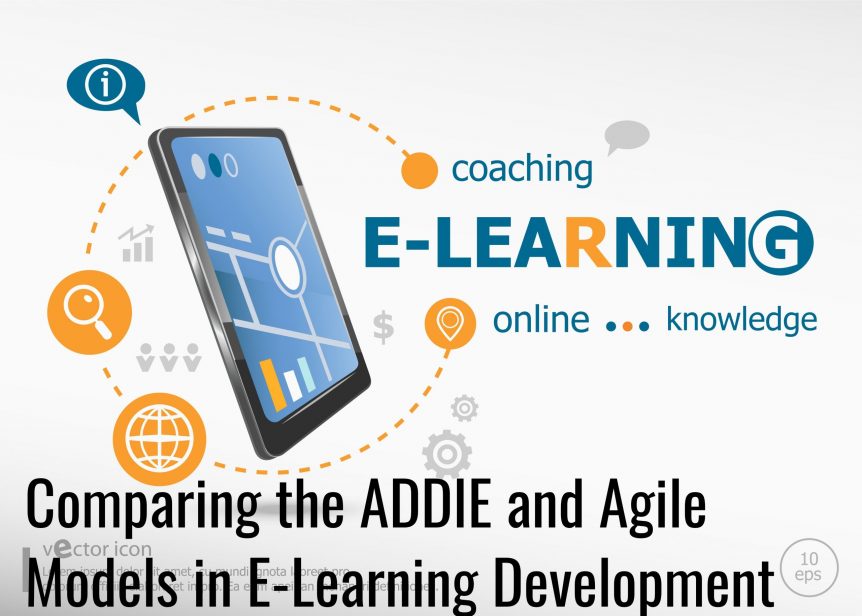Comparing the ADDIE and Agile Models in E-Learning Development
When you hire an e-learning developer to create a training course for your organisation, you will want a successful outcome. That means getting an e-learning course that achieves your training objectives. For this to happen, the development process should also be successful. This requires a structured approach to e-learning development. For most e-learning developers in the UAE, Saudi Arabia, and further afield, there are two main e-learning development models – ADDIE and Agile.
Some companies adopt one of the models, while others use a mixture of the two, depending on the course they are creating.
As you will be part of the development process, it helps to understand the two different approaches and how they compare.
What is the ADDIE Development Model?
ADDIE is an acronym, with each letter representing the five steps in the process that make up this development model. Those steps are:
- Analyse – in e-learning development, this step involves defining the requirements for the e-learning course as well as the audience. Understanding the training objectives is important, too, as well as how success will be measured.
- Design – in this step, the e-learning design and development team will create storyboards, wireframes, and mock-ups for the course, as well as for any new media elements, such as videos. The team will also create scripts, navigational elements, and a schedule for the development process, among other things. In short, this step involves all the required preparation work before you get into full development.
- Develop – the development stage involves putting it all together, creating the content and technical elements of the e-learning course. The content includes text, images, infographics, videos, etc., while the technical elements include implementing the design, creating the navigational structure, coding gamification elements, etc. Testing is also an important part of the development stage.
- Implement – this step is where the e-learning course is distributed to learners for them to complete. It is important to request learner feedback at this stage, in addition to having other methods of evaluation.
- Evaluate – you will now have real feedback and data on the e-learning course, as well as the reaction of learners. This step involves evaluating that feedback and data to assess the success of the course and to identify areas for improvement.
Why Use the ADDIE Development Model?
The ADDIE model for e-learning development follows a linear process. When implemented in its strictest form, you complete a step before moving to the next. The idea behind this comes from the importance of planning and ensuring you have everything right, agreed, and set before proceeding further, rather than continuously going back to change things, repeating tasks you have already done.
What is the Agile Development Model?
In many respects, the agile development model is a more modern approach to e-learning development, although that doesn’t necessarily make it better in all situations.
The biggest difference between the agile model and the ADDIE model is the agile model is not linear. So, instead of going through each step one by one, you analyse, design, and develop at the same time.
What does this mean in practice? There are many ways the agile model can be implemented in e-learning development, but an example would be a situation where a brainstorming session is held. This brainstorming session results in a number of action points. For example, the team could decide to include a branching scenario in the e-learning course or an animated video to explain a complex part of the topic. The team might also decide on the first section of the course.
Rather than waiting for all the analysis and planning work to be completed, however, design and development work on these elements begins without delay. Further analysis and planning continue at the same time on other sections, requirements, and parts of the course. In addition, implementation and evaluation occur continuously.
Why Use the Agile Development Model?
The main benefit of the agile development model is its flexibility, as the process is better at facilitating change than other development approaches, including the ADDIE model. It can also be a faster development approach.
That said, it requires collaboration from the outset with everyone involved, including the development team as well as the client, subject matter experts, and learners. Strong project management is also essential as there are a lot of moving pieces when using the agile development model, with parts of the course at different stages of planning, development, and evaluation.
The Combined Approach
Both the ADDIE and agile model for e-learning development have their drawbacks. The ADDIE model is not as flexible, for example, so decisions need to be made early in the process. This can be difficult as new ideas often only come whenever you start to see the e-learning course take shape.
The agile approach addresses this by building flexibility into the model, but clients usually need to be more involved in the overall process. There can also be more variables in terms of cost, as full requirements and specifications are not clearly defined and agreed at the outset.
As a result, combining the two methods is often the preferred approach for e-learning development. As always, it depends on the situation and the course being developed, but a common approach is to use the ADDIE model early in the process, particularly the analysis step as well as some of the design step. You then switch to the agile model for the rest of the process.
The Right Approach for Your E-Learning Course
The underlying basics of e-learning development are the same for both models. The big difference is one is linear, and one is not. You will probably find the process you go through is the combined approach, although an experienced e-learning developer will be in the best position to give advice on how to proceed with your project.
